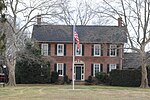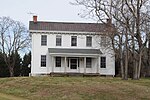Chesapeake & Delaware Canal

The Chesapeake & Delaware Canal (C&D Canal) is a 14-mile (22.5 km)-long, 450-foot (137.2 m)-wide and 35-foot (10.7 m)-deep ship canal that connects the Delaware River with the Chesapeake Bay in the states of Delaware and Maryland in the United States. In the mid‑17th century, mapmaker Augustine Herman observed that these great bodies of water were separated only by a narrow strip of land. In 1764, a survey of possible water routes across the Delmarva Peninsula was made, but little action followed. The idea was raised again in 1788 by regional business leaders, including noted Philadelphians Benjamin Franklin and Benjamin Rush. Despite the beginnings of a commercial venture in 1802—coincident with Canal Mania in England and Wales—it wasn't until 1829 before the C&D Canal Company could, at last, announce the waterway "open for business". Its construction cost of $3.5 million (equivalent to $89.1 million in 2022) made it one of the most expensive canal projects of its time. In the present era, the C&D Canal is owned and operated by the U.S. Army Corps of Engineers, Philadelphia District. The project office in Chesapeake City, Maryland, is also the site of the C&D Canal Museum and Bethel Bridge Lighthouse. The canal saves approximately 300 miles on the route between Wilmington or Philadelphia on the Delaware River and Baltimore on Chesapeake Bay, avoiding a course around the Delmarva Peninsula. The canal is itself a significant landmark and cultural boundary for the state of Delaware, considered a divide between the urbanized northern portion of the state and the rural southern portion known locally as "Lower Delaware", and demarcates an unofficial northern limit to the Delmarva Peninsula.
Excerpt from the Wikipedia article Chesapeake & Delaware Canal (License: CC BY-SA 3.0, Authors, Images).Chesapeake & Delaware Canal
Michael N. Castle Trail,
Geographical coordinates (GPS) Address Nearby Places Show on map
Geographical coordinates (GPS)
| Latitude | Longitude |
|---|---|
| N 39.542777777778 ° | E -75.720555555556 ° |
Address
Michael N. Castle Trail
Michael N. Castle Trail
Delaware, United States
Open on Google Maps








